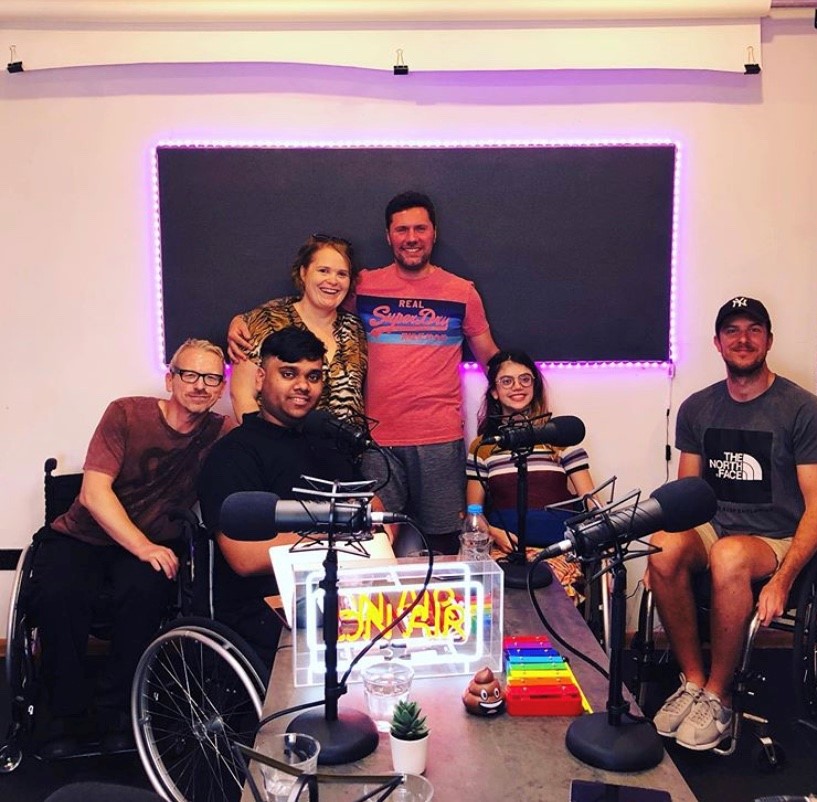Student profile: Rubayet Ahmed
Rubayet is a third-year History student at Queen Mary. In 2018, he suffered a life-changing injury whilst on holiday which left him paraplegic. Ready to continue his studies after a year off, he shares his inspiring story about living with a spinal cord injury, as well as the fantastic podcast he is involved in.

The "This is Spinal Crap" team. Rubayet is pictured in the front row, second from left.
Tell us a little bit about yourself?
I arrived in the UK in 2012 and in 2016 I began studying History at Queen Mary. During the summer between my second and third year, I suffered a spinal cord injury. I fell off a cliff whilst riding a quad bike on holiday. This injury has left me completely paralysed from the waist below. A year later, I have returned to Queen Mary to complete my studies.
What is “This is Spinal Crap” about?
“This is Spinal Crap” is a podcast about living well with a spinal cord injury. Through the use of humour and positivity, we discuss sensitive topics around spinal cord injuries.
Who else is involved in the podcast?
The team is made of six members including myself; Ruth, Chris, Ian, Grace and last but not least, Mark.
How did “This is Spinal Crap” start?
After meeting at the inter-spinal unit games (ISUG), we realised that we each had similar outlooks when dealing with our injuries. Therefore, our amazing host, Ruth, decided that it would a great idea to share our experiences.
How did you come up with the name?
The name reflects our values of humour and positivity when discussing the sensitivities surrounding spinal cord injuries.
What were your aims when releasing the podcast?
Our aim is to inspire and to show people with spinal cord injuries that it is possible to lead a normal life despite the challenges. We also hope to educate people about the everyday issues of living with a spinal cord injury.
Why is the podcast of importance?
Unfortunately, there aren’t many resources about spinal cord injuries. Therefore, we believe that our podcast is a valuable resource for anyone.
Who is your target audience?
Our target audience are people with spinal cord injuries. We want to help them to cope with their injury and to help them to see that it is still possible to live well. We also aim to bring this to the attention of people who are unaware of the life-changing impact of having a spinal cord injury, as we have noticed a lot of ignorance surrounding the topic.
What do you want your target audience to take away from the podcast?
A smile on their face and knowledge about spinal cord injuries.
What’s the feedback on the podcast been like?
The feedback on the podcast has been very positive. From the comments, we are happy to see that people are enjoying our discussions whilst simultaneously learning about spinal cord injuries. Our audience may cry a little, but they laugh a lot more. Most importantly, we give them a sense of optimism with our uplifting nature. Some say: “If only our world leaders acted with the same courage and humour as the podcasters, the world would be indeed a better place.”
How has your life changed since your spinal cord injury?
Most things became more challenging. However, my life has not changed as much as I thought it would. My friends and family helped to bring a sense of normality into my life. Technology and accessibility allowed me to carry on with my studies, to drive and play sports. This is specific to my journey as a paraplegic; I now enjoy the little things in life.
What advice would you give to someone who has suffered a spinal cord injury?
Reach out for help to your close friends, family and charities. Try to stay positive, regardless of how hard it can get and try to enjoy the simple things in life.
Series 1 of "This is Spinal Crap" is available to stream on Spotify and Apple Podcasts.